unit2_poems_language_points公开课
- 格式:ppt
- 大小:2.41 MB
- 文档页数:35
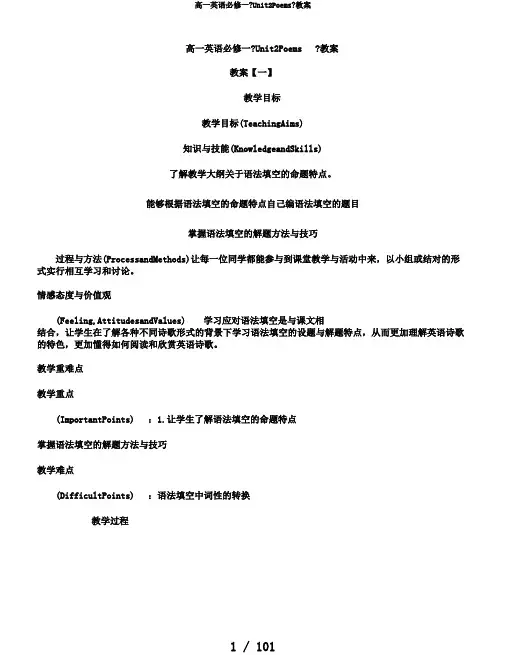
高一英语必修一?Unit2Poems ?教案教案【一】教学目标教学目标(TeachingAims)知识与技能(KnowledgeandSkills)了解教学大纲关于语法填空的命题特点。
能够根据语法填空的命题特点自己编语法填空的题目掌握语法填空的解题方法与技巧过程与方法(ProcessandMethods)让每一位同学都能参与到课堂教学与活动中来,以小组或结对的形式实行相互学习和讨论。
情感态度与价值观(Feeling,AttitudesandValues) 学习应对语法填空是与课文相结合,让学生在了解各种不同诗歌形式的背景下学习语法填空的设题与解题特点,从而更加理解英语诗歌的特色,更加懂得如何阅读和欣赏英语诗歌。
教学重难点教学重点(ImportantPoints) :1.让学生了解语法填空的命题特点掌握语法填空的解题方法与技巧教学难点(DifficultPoints) :语法填空中词性的转换教学过程(Teachers’Activities)StepI :Lead-inReviewthenewwordsandexpressionsofthisunitbythemtogether,andthendoTask1---speakouttheotherformsaccordingtothegivenwords ListentothesongJingleBellsandtrytofillawordintoeachblank.StepII :Pre-practisingQuestionsDoyouthinkitisdifficulttocompletetheitemsofblank-fillingwithgrammarknowledge?②Haveyoufiguredoutthe characteristicsoftheitem?2.ExplainingInthisitemthereare10blanksforyoutofillinwithlessthanoneproperword someblankswithagivenwordwhileotherswithnonefillintheblankswiththeproperformofthegivenwordaccordingtoitsgrammaticalandlogicalmeaning. chooseapreposition,pronoun,conjunctionoranarticletofillintheblankwithoutanygivenword. DiscussionHowcanwefinishtheitemsstepbystepwithourgrammarknowledge?___________________________________________.___________________________________________.___________________________________________.StepIII:While-practisingMakinganitemofgrammaticalblank-fillingbasedon theparagraphofthetext.morethan5blanks.someblankswithgivenword.otherswithnone.exchangetheitemyoumadeforyourpartnertocompleteit.Thewholeclassfinishtheonetheteacherpreparedforthem.StepIV:Post-practisingsomeofthestudents’anwsersandgivecomments.aconclusionStepV :HomeworkAssignmentFurtherimproveyourskillsofdealingwiththegrammarfilling.onPage10,NanfangNewClass教案【二】教学准备教学目标Teachinggoals1.Targetlanguagea.ImportantwordsandphrasesPoem,poetry,recite,aspect,convey,nursery,rhyme,diamond,cottage,balloon,sparrow,tease,sal ty,endless,translate,nurseryrhyme,takeiteasy,runoutof,makeupofb.ImportantsentencesWhichpoemisaboutthingsthatdon ’tmakesense?Poetsusemanydifferentformsofpoemstoexpressthemselves.Ihadn’ttakenmyeyeofftheball.Wehadn’ttakeniteasy.Thepoemismadeupoffivelines.AlotofTangpoetryhasbeentranslatedintoEnglish.ThetranslationshaveafreeformthatE nglishpeopleliketocopy.2.Abilitygoalsa.EnableSstotalkaboutdifferenttypesofpoems:nurseryrhymes;listpoems;cinquain,;haiku;Tangpoemsb.EnableSstotalkaboutdifferentpurposesofwritingpoems.c.Understandthemainthemeofeachpoem.d.EnableSstochantsomeoftheirfavoritepoems.3.LearningabilityEnableSstodistinguishdifferenttypesofpoems教学重难点TeachingimportantpointsTalkaboutfivemaintypesofpoems.Understandthemainpurposeofwritingthepoems.Teachingdifficultpoints Findtherhythmofeachpoem.Chantthepoem.Understandthemainpurposeofwritingthepoems.教学过程Teachingprocedures&waysStep1.GreetingsStep2.PresentationAskSstothinkbackandtrytorememberpoemsfromtheirearlychildhood, eitherinChineseorinEnglish.Talkaboutsomefamouspoetsbothhomeandabroad,eitherancientonesormodernones.Brainstorming:Whatwillyouthinkofwhenwetalkabouttheword“poem〞?Step3.WarmingupReadthequestionsinthispart,remindingSswhattheynoticeabouttheabovepoems.(e.g.theyhaveastr ongbeat,ortheyhaverhyme,ortheyplaywithwordsandsounds,orperhapssomeofthemarefunnybecausetheym akenosense.)TellSsthattherearemanyreasonswhypeoplewritepoetry.GivetheexamplesontheBb.AskSswhytheythinkth epoetswrotethepoemstheyhavejustrecited..Writetheirsuggestionsontheboard. GiveSsatimelimitofafewminutes.Dividetheclassintogroupsoffourtodiscussthepurposeofwritingpoem s.Askonepersonfromeachgrouptoreadtheirgroup’slistandaddtheirsuggestionstothelistontheboard. (Suggestedreasons:tocreatecertainfeelingsorimagesinthereader;toshareafeelingorexperience;todescribesomethingin detailorgiveanimpression;togetthereadertothinkaboutanidea;toexpressapointofview;tomaketherea derexperiencethesight,sounds,smells,feelandtastesofsomething;tocreateamood,toplaywithwords---theirsounds,rhymeandrhythm.)Iftimepermits,insmallgroupsorasaclass,discussthekindsoftopicsthatpoetswriteabout.(people ,animals,nature,landscapes,thesea,theseasons,stories,death,war,youthandoldage,feelingandexpe riences,emotionslikelove,hate,sadness,regretanddesire,etc.)Step4.Pre-readingPeoplefromdifferentcountrieswritedifferentkindsofpoems.GetSstodiscussthequestionsonPage9withtheirpartners:DoyouhaveafavoritepoeminChinese?Why?DoyouhaveafavoritepoeminEnglish?Why?Astoexercise2,giveSspracticeinanimportantreadingskill:scanningatext,thatis,lookingthroughatextquicklytofindspecificinformation.Readthetableinexerc ise2withtheSs.Tellthemthattheyaregoingtolookfortheinformationinthetable,justinthepoemsthemse lves,notintheotherpartsofthetext.Theyaretolookonlyforthosepiecesofinformationandnotreadevery word.Doanexamplewiththem.Suggestedanswerstoexercise2 :Step5.ReadingScanningGettheSstoreadthepassagequicklyandaccuratelyandmeanwhilehelptheSstoformagoodhabitofreadi ng.TeachergivesSsacoupleofminutestolookthroughthewholepassage.Tellthemtoreadthetextsilentlya ndthenasksomedetailedquestionsaboutthetextontheslideshow.TeachershouldencourageSstoexpressth eirideas.Q1.Whydopeoplewritepoetry?Q2.Howmanyformsofpoemsarementionedinthepassage?Whatarethey?Q3.Whatdoes“nurseryrhyme〞mean?Whydotheydelightsmallchildren?Q4.What’sthecharacteristicof“listpoems〞?Whatabout“cinquain〞?Q5.WhydoEnglishPeoplelike “Haiku〞?Q6.AreyoufamiliarwithTangPoems?Doyouknowthetitleofthelastpoeminthetext?ListeningBeforeSsreadthetext,havethemclosetheirbooksandlistentothetextwiththeireyesclosed.ThisgivesSstheopportunitytolistentothesoundsor “music〞ofthepoemsbeforereadingthemindetail.Tellthemthatitdoesn ’tmatteriftheydon ’tunderstandeveryword.FirstreadingGetSstoreadthetextcarefully,findingtheone sentencethatsumsuptheparagraphofeachpart..Underlinethetopicsentence.SecondreadingTellSsthattheyaregoingtolookattherhythmoftwoofthepoems.Makesuretheyknowwhatrhythmis.ReadthelimerickaloudandhaveSslistenforthestrongbeats .Thenhavethemclapthestrongbeatsasyouread.Markthestrongbeatsonthelimerickontheboard. TherewasanoldmanwithabeardWhosaid“itisjustas Ifeared 〞.“FourinsectsandthenTwobirdsandahenHaveallmadeahomeinmybeard 〞.NowreadthepoemA&B.Askthemtomarkthestrongbeatsonthetwopoemsthathaveastrongrhythm.Checktheiran swers.Thenplaythetapeandgetthemtoclaptothestrongbeatsinthosetwopoems.ThirdreadingJustasanyscenecanserveasthesubjectofapainting, soanypartofdailylifecanprovidematerialforapoem..Ofcourse,thechoicethattheartistorpoetmakesre latestohisorherpurpose.Poetryisusuallyshortandcompact,soitshouldbereadseveraltimes,preferabl yaloud,toappreciateitsmeaning.Readthelastpoem(PoemH),andanswerthefollowingquestions :Q1.Whatpartsofthepoemsuggestthatthewomanlovesherhusband?Q2.Howdoyouunderstandthesentence〞journeyerreturn,thisstonewouldutterspeech.thesentence inyourownwords.Shouldthe 〞?ExplainQ3.Whatpicturedoyouhaveinyourmindwhenyoureadtheabovesentences?Q4.DoyouknowtheChinesetitleofthispoem?DoyouknowtheChineseversionofthepoem? Step6.Makeashortsummaryofthisperiod.课后习题HomeworkSurfsomewebsitestofindoutmoreinformationaboutpoets.Reviewthecontentofthereadingpassage.2.FinishtheexercisesonPage12&13.。

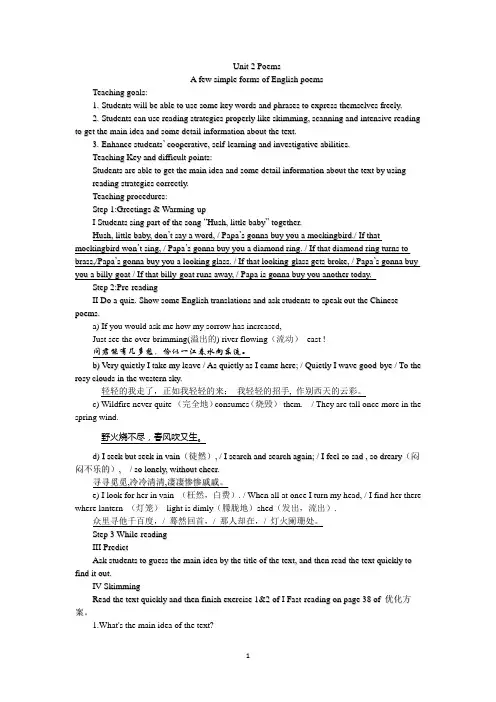
U n i t2P o e m sA f e w s i m p l e f o r m s o f E n g l i s h p o e m sT e a c h i n g g o a l s:1.S t u d e n t s w i l l b e a b l e t o u s e s o m e k e y w o r d s a n d p h r a s e s t o e x p r e s s t h e m s e l v e s f r e e l y.2.S t u d e n t s c a n u s e r e a d i n g s t r a t e g i e s p r o p e r l y l i k e s k i m m i n g,s c a n n i n g a n d i n t e n s i v e r e a d i n g t o g e t t h e m a i n i d e a a n d s o m e d e t a i l i n f o r m a t i o n a b o u t t h e t e x t.3.E n h a n c e s t u d e n t s’c o o p e r a t i v e,s e l f-l e a r n i n g a n d i n v e s t i g a t i v e a b i l i t i e s.T e a c h i n g K e y a n d d i f f i c u l t p o i n t s:S t u d e n t s a r e a b l e t o g e t t h e m a i n i d e a a n d s o m e d e t a i l i n f o r m a t i o n a b o u t t h e t e x t b y u s i n gr e a d i n g s t r a t e g i e s c o r r e c t l y.T e a c h i n g p r o c e d u r e s:S t e p1:G r e e t i n g s&W a r m i n g-u pI S t u d e n t s s i n g p a r t o f t h e s o n g“H u s h,l i t t l e b a b y”t o g e t h e r.H u s h,l i t t l e b a b y,d o n’t s a y a w o r d,/P a p a’s g o n n a b u y y o u a m o c k i n g b i r d./I f t h a tm o c k i n g b i r d w o n’t s i n g,/P a p a’s g o n n a b u y y o u a d i a m o n d r i n g./I f t h a t d i a m o n d r i n g t u r n s t ob r a s s,/P a p a’s g o n n a b u y y o u a l o o k i n g g l a s s./I f t h a t l o o k i n g-g l a s s g e t s b r o k e,/P a p a’s g o n n a b u y y o u a b i l l y-g o a t/I f t h a t b i l l y-g o a t r u n s a w a y,/P a p a i s g o n n a b u y y o u a n o t h e r t o d a y.S t e p2:P r e-r e a d i n gII D o a q u i z.S h o w s o m e E n g l i s h t r a n s l a t i o n s a n d a s k s t u d e n t s t o s p e a k o u t t h e C h i n e s ep o e m s.a) If you would ask me how my sorrow has increased,Just see the over-brimming(溢出的) river flowing(流动)east !问君能有几多愁,恰似一江春水向东流。
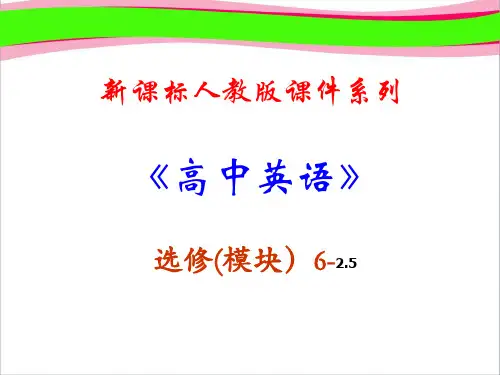

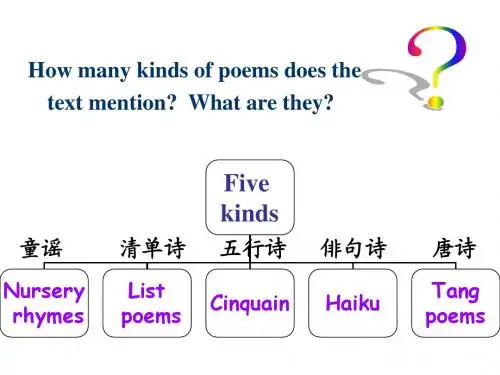
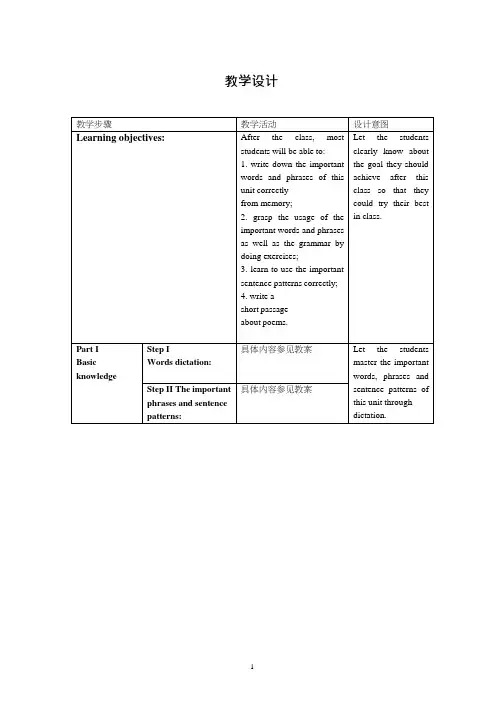
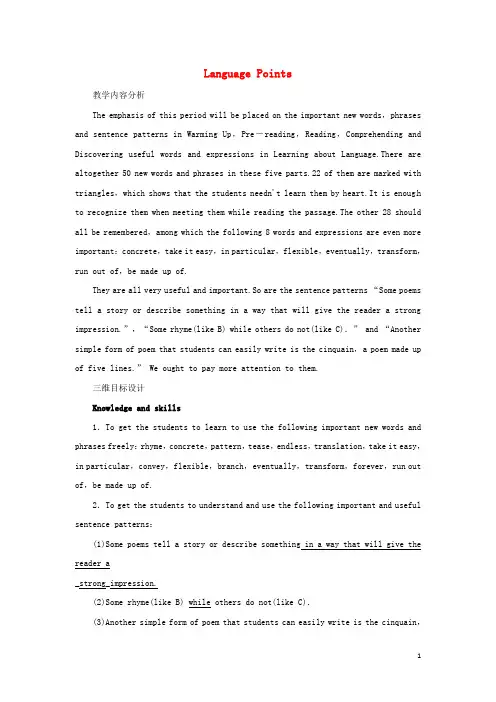
Language Points教学内容分析The emphasis of this period will be placed on the important new words,phrases and sentence patterns in Warming Up,Pre-reading,Reading,Comprehending and Discovering useful words and expressions in Learning about Language.There are altogether 50 new words and phrases in these five parts.22 of them are marked with triangles,which shows that the students needn't learn them by heart.It is enoug h to recognize them when meeting them while reading the passage.The other 28 should all be remembered,among which the following 8 words and expressions are even more important:concrete,take it easy,in particular,flexible,eventually,transform,run out of,be made up of.They are all very useful and important.So are the sentence patterns “Some poems tell a story or describe something in a way that will give the reader a strong impression.”,“Some rhyme(like B) while others do not(like C).” and “Another simple form of poem that students can easily write is the cinquain,a poem made up of five lines.” We o ught to pay more attention to them.三维目标设计Knowledge and skills1.To get the students to learn to use the following important new words and phrases freely:rhyme,concrete,pattern,tease,endless,translation,take it easy,in particular,convey,flexible,branch,eventually,transform,forever,run out of,be made up of.2.To get the students to understand and use the following important and useful sentence patterns:(1)Some poems tell a story or describe something in a way that will give the reader a_strong_impression.(2)Some rhyme(like B) while others do not(like C).(3)Another simple form of poem that students can easily write is the cinquain,a poem made up of five lines.Process and methods1.To help the students to understand the meanings of the above useful new words and expressions in the context,and then give some explanations about them,and at last offer some exercises to make the students master their usages.2.To ask the students to make up their own sentences by imitating the above sentence patterns.3.At t he end of the class,make students do more exercises for consolidation.In doing so,they can learn,grasp and use these important language points well.Emotion,attitude and value1.To stimulate students' interest in learning English.2.To develop students' sense of cooperation and teamwork.教学重、难点1.Important new words and expressions:rhyme,concrete,pattern,tease,endless,translation,take it easy,in particular,convey,flexible,branch,eventually,transform,forever,run out of,be made up of.2.Important and useful sentence patterns:(1)The attributive clause with the antecedent “way”.(2)Compound sentences with “while”.(3)Past participles as the postpositive attributive.3.Some difficult and long sentences in the text.教学过程Step 1Revision1.Check the homework exercises.2.Ask some students to tell about some simple forms of English poems.Step 2Reading and findingGet students to read through Warming Up,Pre-reading,Reading,Comprehending and Discovering useful words and expressions in Learning about Language to underline all the new words and useful expressions or collocations in these parts.Read them aloud and copy them down in the exercise book.Step 3Practice for useful words and expressions1.Turn to Page 12.Go through the exercises in Discovering useful words and expressions with students and make sure they know what to do.2.Give them several minutes to finish the exercises.They may first do them individually,and then discuss them with their partners.3.Check the answers with the whole class and explain the problems they meet where necessary.Step 4Vocabulary studyI. 简单知识汇总1.poem/poetry(P9)Poet(P10)These little poems and songs might have been some of the first poetry you learned.这些小诗歌或许就是你最早学到的一些诗歌。

Period 5 Reading and Writing整体设计教学内容分析The teaching materials of this period contain two parts.The first part is the reading passage on Page 14 with the title of I've Saved the Summer,which is a poem telling a parent sp eaking to a young adult child.The older person has experienced his/her own journey through life and is offering love to the young person to help him/her begin on his/her own journey through life.The second part is the Writing Task on Page 54,which asks the students to write a poem.Knowledge and skills1.To enable the st udents to listen to the “music” of the poem,to know how it makes them feel and what it makes them think about.2.To get the students to learn the following useful new words and phrases:appropriate,exchange,sponsor,darkness,try out,let out.3.To get the students to learn the following useful structure:If I+past tense...,I would...4.To help the students learn how to write a poem starting with “If I...”.5.To foster the students' ability in skimming and looking up information in reference books and improve the students' reading ability.Process and methodsReading for specific information,summarizing,discussing and practicing.Emotion,attitude and value1.To stimulate the students' love to poetry.2.To inspire the students to write poems of their own.教学重、难点1.The understanding of the reading passage.2.The use of the subjunctive mood in poem writing.3.Teaching the students how to write a poem of their own.教学过程Step 1RevisionCheck the answers to the grammar exercises on Page 13 and explain the difficult ones.Step 2Pre-readingListen to the poem “I've saved the summer” and answer these questions:1.Do you think the speaker in the poem is more likely to be a girlfriend/boyfriend or a parent?2.Does the poem have a rhythmic pattern?3.Does the poem have rhyming words?4.When you were listening to the poem,did it make you feel something or think about something? What did it make you feel or think about?Suggested answers:1.Students' answers may vary.2.Yes(it has two strong beats per line).3.Yes.4.Students' answers may vary.Step 3Reading1.Circle the words that rhyme.What is unusual about the rhyming words in the last four lines?2.Try beating or clapping the strong beats of the rhythm as you read the poem to yourself.Now listen to the poem again and clap the strong beats.Suggested answers:1.Circled words:you,new;need,feed;nineteen,mean;way,day;own,own.The rhyming words in the last four lines are unusual because they are the same word although they each have a different meaning.2.The strong beats of the rhythm are marked below:I've saved the sum merAnd I give it all to youTo hold on winter morn ingsWhen the snow is new.I've saved some sun lightIf you should ever needA place away from dark nessWhere your mind can feed.And for myself I've kept your smileWhen you were but nine teenTill you're older you'll not knowWhat brave young smiles can mean.I know no ans wersTo help you on your wayThe ans wers lie some whereAt the bott om of the day.But if you've a need for loveI'll give you all I ownIt might help you down the roadTill you've found your own.Step 4DiscussionIn small groups discuss these questions:1.Who is the speaker in the poem and who is he/she speaking to? Give reasons to support your answer.2.Which of the following is the closest to the speaker's message? Give a reason for your choice.A.If it's cold,I'll warm you;if it's dark,I'll give you light;if you're hungry,I'll feed you;if you want love,I'll give it to you.B.Although the future may be difficult for you,whenever you need warmth and love,remember I'll have some to give you.C.While you're away I'll remember your smile and I'll love you always.When you return,I hope you will love me.Suggested answers:1.A parent(mother or father)speaking to a young adult child(son or daughter).We know that the speaker is probably a parent because he/she is offering the child unconditional love(But if you've a need for love,I'll give you all I own).We know that the son/daughter is a young adult because the speaker refers to the time when you were but nineteen.2.BStep 5Language studyShow the students the following language points in a slide show.1.appropriate(P13)【原句再现】Match the beginning of each sentence with the appropriate ending.把每个句子的开头与其合适的结尾连在一起。
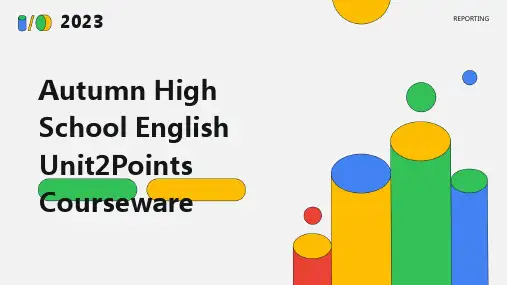

如何使用英语Unit2Poems的教案进行教学。
一、教材概述鉴于本教案是围绕“Unit2 Poems”展开的,因此,我们需要先对“Unit2 Poems ”进行一个整体性的了解。
关于“Unit2 Poems ”,它是英语教材中的一个单元。
在这个单元里,我们将学习诗歌的写作技巧以及创作灵感,也将了解到一些英语经典诗篇的意境和韵律。
二、教学目标1.了解英语诗歌的写作技巧和创作灵感;2.掌握英语诗歌的基本韵律和诗体;3.学会分析英语经典诗篇的意境和文化内涵;4.能够自行创作英语诗歌。
三、教学重点1.英语诗歌的写作技巧和创作灵感;2.英语诗歌的基本韵律和诗体;3.英语经典诗篇的意境和文化内涵。
四、教学方法1.书面讲解,帮助学生了解诗歌的写作技巧和创作灵感;2.字面训练,让学生对英语诗歌的韵律有实际掌握;3.分析诗歌,帮助学生认识英语经典诗篇的意境和文化内涵。
五、教学步骤1.教师向学生介绍“Unit 2 Poems”单元,并简要讲解本单位置的教学目标和教学重点;2.介绍英语诗歌的基本知识,包括英语诗歌的韵律和诗体等;3.教师帮助学生了解诗歌的写作技巧和创作灵感,并通过介绍一些经典的英语诗歌进行解析;4.通过字面训练,让学生练习英文诗歌的韵律和韵脚;5.分析英语经典诗篇,帮助学生认识诗歌的意境和文化内涵,并引导学生分析和创作英语诗歌;6.教师和学生互动交流,确保学生真正理解和掌握了所学知识。
六、教学效果的评估在教学的过程中,教师可以通过以下方式来评估教学的效果:1.听学生发言,了解学生是否真正明白了所学知识;2.通过分组讨论或个人笔试等方式来评估学生所掌握的知识程度;3.教师可以看学生的创作成果,来看学生是否真正掌握了诗歌的写作技巧。
七、总结通过对“Unit2 Poems ”教案的解析,可以看出,在教学过程中,我们需要充分利用各种教学资源,特别是教案资源,来为我们的教学提供有力支持。
而在具体上课过程中,我们还需要把握好教学的目标、方法和效果评估等关键点,才能真正帮助学生掌握英语诗歌的基本知识和创作技巧,从而提高学生英语语言和文学素养的水平。
Unit 2 Poems Ⅰ. 单元教学目标Ⅱ. 目标语言Ⅲ. 教材分析与教材重组1. 教材分析本单元以Poems为话题,从学生初次接触诗歌,一直谈到诗歌创作的动机、有关诗歌的一些基本知识(包括诗歌的种类、风格)等。
旨在通过本单元的学习,使学生在初步了解和掌握诗歌这一文学形式的基本常识的基础上,进行简单的诗歌创作。
1.1 Warming Up部分要求学生回顾所学诗歌,启发学生以小组活动形式分析、列举人们进行诗歌创作的原因。
1.2 Pre-reading 部分首先要求学生说出自己最喜欢的中英文诗歌并阐明理由;然后通过快速阅读Reading部分内容填写列表,区分诗歌种类。
1.3 Reading部分是一篇介绍诗歌基础知识的文章。
文章从诗歌创作的动机、种类、特点及读者对象等方面简要介绍了五种不同风格、特色的诗歌。
1.4 Comprehending 部分根据阅读内容设置了三个习题。
第一个习题要求学生通过读文章、听录音感受诗歌特色,判断自己所喜欢的诗歌类型并说出理由;第二个习题就文章总体内容提出了五个问题,帮助学生进一步了解不同类型诗歌的不同特点;第三个习题通过十一个具体问题考查学生对文中某些细节内容的理解并要求分析诗歌创作者的情感、态度。
1.5 Learning about Language分words and expressions和structures两部分。
第一部分设置了两个练习:第1个练习要求从所学诗歌中找出与所给词汇压韵的词并添加其它韵词;第2个练习要求用所给词汇的正确形式填空。
第二部分通过四个小练习对所学诗歌中出现的两种结构形式进行训练。
1.6 Using Language共设置了三个任务:第一项任务通过一首小诗展开听力、口语、阅读训练,加深学生对诗歌韵律知识的理解;第二项任务通过Miss Jiang与学生谈论诗歌竞赛的一段录音学习,练习“意愿(intentions)”的表达。
第三项任务要求学生运用所学诗歌知识,根据所给提示进行模仿习作训练。